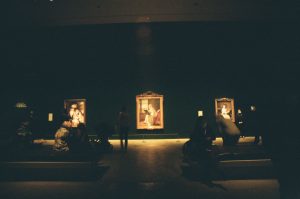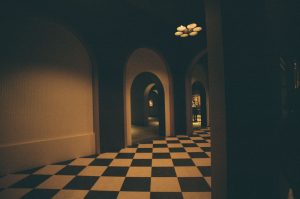
By Samantha Hope
Making their way across the world from the Metropolitan Museum of Art New York, to us here in Brisbane, 65 masterpieces covering 500 years of art history have been put on display in the Gallery of Modern Art, giving us the opportunity to see these renowned MET artworks in our own backyard. This is quite poignant given the current global pandemic we have found ourselves in; even if we wanted to travel across the globe to see these works in their ‘natural habitat’, that is something that still seems to be far in the future.
This exhibition lures you in, down its intriguing hallway of arches leading into darkness and opening into a large subdued room, walls painted a deep black, with chain-mail arches suspended from the ceiling – each work lit in grandeur, highlighting their ornate traditional frames. The archway thematic continues as you make your way through the maze of artworks trying to follow the order on the map and navigating through the crowd whilst attempting to find relatively pleasing vantage points for each piece.
This first area of the exhibition ‘Devotion and Renaissance’ complied works with religious, dark, foreboding contexts with hints to the portraiture to come: highlighting the female form as can be seen in The Judgement of Paris (1528) by Lucas Cranach the Elder. The works vary in sizes, some monstrous while others beckon you to come as close to seek detail; some works framed in glass and others without – yet each work has been installed with its own air of importance and significance and the entirety of the exhibition having an underlying sense of being together yet separate. The coldness of the gallery radiates from the concrete floor and highlights the intensity of these works and the seriousness of their sacredness. These works have been exquisitely preserved and maintained, it is hard to believe how old they are and how they have survived the tests of time: in most works there is evidence of cracks and aging – however this does not detract from the pieces at all, rather bringing their age to our attention and demanding respect. Madonna and Child (1480) by Carlo Crivelli is impeccably preserved, showing very little signs of aging at all yet somehow dating back to 1480. The maze-like structure of this first section feels slightly disjointed, within the separate rooms of this space there are large corners with blank walls that almost feel as though something is missing.
The deep peacock green of the walls in the following section highlights the traditional golden decorative frames, making these masterpieces pop and giving us a feast for the eyes. The room bursts to life with portraiture and genre paintings of Absolutism and Enlightenment. These works give us an insight to the lives and daily happenings of life long ago – but as stated in the description of Rembrandts portrait of his wife ‘Flora’ (1654) – these depictions are not all necessarily realistic or literal as his work was one that was romanticised and manipulated to be a more idealised version of reality. Within these works we also see more animals: horses, dogs and cats – showing how our relationship with the world and its creatures is changing and adapting through time.

This cohesiveness was met with a jarring high contrast by a smaller room within, with rich red walls violent and bloody as they engulf you and berates your eyes. This was odd given the images in this room were not violent but rather landscapes and serene portraiture pieces, all of which were quite soothing in comparison to the deep crimson wall they are hung upon.
The male portraits throughout this exhibition are quite serious, formal and stern: encapsulating details of the subject in a pose or undergoing a task, whereas female portraits are highly beautified, romanticised, and exposing of their bodies, all the while not taking part in any activity other than caring for a child. Of course, there is one painting in which women take part in an activity: Edgar Degas’ Dancers, Pink and Green (1890), depicting ballerinas – once again though this is showing women in quite the romanticised and idealised ideology of the male gaze.
Leaving this first set of exhibition spaces we find ourselves in ‘The Studio’ where a playground for artists has been manufactured allowing for visitors to practice their still life drawing both with directed objects and live models. There is also a stage where you can watch live music performances, however, they only run 11:00am -1:00pm, so if you get stuck in line outside waiting to enter the exhibition (like I did on my second visit) you may miss this entirely. The entire space has been decorated and fitted with objects similar to and reminiscent of those in the paintings in the preceding and following rooms. It is quite a shame this space is isolated within the middle of the exhibition as the urge to continue on to see the rest of the works pushes you forward through the space with a mentality of ‘we’ll come back to that’. Once you leave the exhibition entirely you cannot regain access to the studio unless you purchase another ticket for second viewing of the works. It would be beneficial and far more accessible if this space was separate from the exhibition and could be accessed for free, and with more time to partake in the activities.
The final section of the exhibition ‘Revolution and Art for the People’ houses the most familiar ‘household names’: Manet, Monet, Renoir, Van Gogh, and Cezanne. The colour choice for the exhibition walls in the last space was surprising, but in a disappointing manner as the rest seemed so stylized and dramatic. This final room was more akin to the traditional contemporary gallery space with a slightly off white colour palette, the only pop of colour in the arches. Walking through the space I could over-hear the phrases, “oh I think this is a famous one,” and, “I’ve seen this one before”. It is important to differentiate between seeing an artwork properly in the flesh or seeing it online or in print. The way you view an artwork can change the affectual quality and the overall viewing experience. While you may have ‘seen’ it before digitally you haven’t really experienced it – being able to witness the scale, texture, colour and detail first-hand is an entirely superior viewing experience.
This exhibition highlights some of the European Masterpieces from the 500 years that has been curated. If all of the masterpieces from this time were to be exhibited together, I’m sure we would need a much larger exhibition space, as well as the collaboration and inclusion of other galleries. This exhibition provides a glimpse into the art forms, genres, and artists on display at the MET, with the leisure of not having to fly all the way over to New York (which isn’t even an option right now). We have been incredibly fortunate to have this exhibition come to us, and for it to be so beautifully and satisfyingly curated and installed by the team at the Gallery of Modern Art. I urge you to go and really see these works while they are here before the exhibition closes on October 17.

Sam is new to Brisbane, originally from Cairns, and has a passion for the Creative Arts, specifically: Visual Arts and Photography. She is currently studying her Bachelor of Arts, practicing her own art and photography practice.






